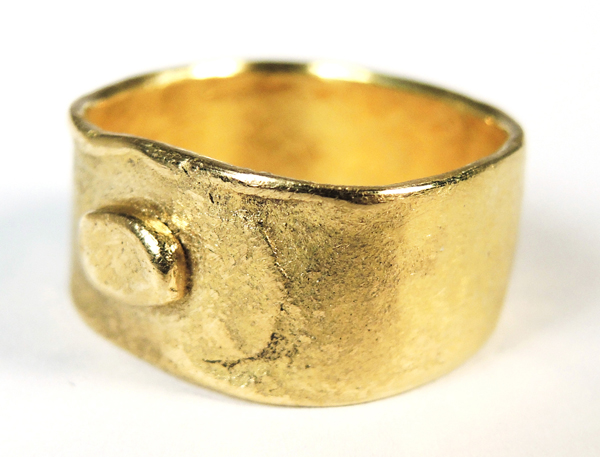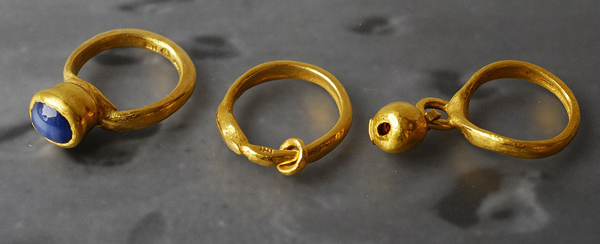
Susan Cummins: Were you born and raised in New Zealand?
Ann Culy: Yes, in Lower Hutt, New Zealand.
Can you tell the story of how you became a jeweler?
Ann Culy: I discovered working with metal at art school, in the printmaking studio and in the sculpture department, where I worked on a small scale using lost-wax casting in bronze. The combination of melting, pouring, and manipulation of metal has been a constant joy and led me directly to jewelry making, where I can fuse all those skills together.

Susan Cummins: Were you born and raised in New Zealand?
Ann Culy: Yes, in Lower Hutt, New Zealand.
Can you tell the story of how you became a jeweler?
Ann Culy: I discovered working with metal at art school, in the printmaking studio and in the sculpture department, where I worked on a small scale using lost-wax casting in bronze. The combination of melting, pouring, and manipulation of metal has been a constant joy and led me directly to jewelry making, where I can fuse all those skills together.
Where did you study?
Ann Culy: I attended Ilam School of Fine Arts in Canterbury, New Zealand, majoring in sculpture (1971–1974), and Otago Polytech, Craft & Design (1991).

The title of your exhibition is plain gold ring has a story to tell. What kinds of stories do you imagine rings tell?
Ann Culy: Rings have that fantastic ability to be with the person in a way that becomes a signature, an intimate gesture of personality and history.
I remember looking down at my mother’s hands clasped in that cool peace of death, her plain gold ring sitting quietly as part of the life she had lived. I want to make rings that encompass a story, become one with the wearer. Intimate, yet clearly of the person.

Ann Culy: Ring with a Ring has a small movable element that works as a reminder, an irritant, a folly, and a wee message. I started with a simple question—what is a ring? What job does it do? A ring reflects all the aspects of living: linking, describing the trust and connections in our relationships, signing our personalities, passing on our stories, and wearing out. It is wrapped around a finger to be there in all the simple acts of being alive.
You use 22-karat gold for many of your rings. Isn’t that an awfully soft material for a ring? Why do you use it?
Ann Culy: I use either 22-karat or pure gold, as I love its color and flexibility. The rings I make are intended to be worn a lot and to become part of the wearer’s hands, the shape evolving as they are worn. I am comfortable with the soft metal and its history. The rings are strong enough to enjoy a long life on someone’s hand. For this series, I started with 2 ounces of pure gold, building each ring to reflect a different mood or circumstance of the day. This allows the wearing and the making to talk to each other. I enjoy the challenge of working in a limited palette with unlimited solutions.
Your rings have a kind of primitive-looking quality to them, like something from ancient Greece. Can you explain your process?
Ann Culy: I do use ancient techniques in my making, they still hold fast. I mix and pour my own ingots. The rings have no solder; they are constructed simply by forging, fusing, filing, burnishing, and stamping. I like that they can easily be returned to the metal they came from with the melt of a flame.
The shaping and fusing of the gold is much like making a watercolor painting. There is no room for mistakes, or if they do happen you have to be able to accommodate and celebrate where they lead you. I have to be comfortable with each ring being so individual and fresh, with the workings of the process still being visible but not interrupting the flow and intention of the shape—of letting the gold speak.
Thinking about the shape of the finger, the hand, the movement of the wrist—it all comes into play when the fine-tuning and subtle scale of a ring is being made.
Making a fluid, joyful line become solid is what makes the job so satisfying.

You had a piece in the Wunderrūma exhibition shown at Galerie Handwerk in Munich last year. Did you think it was a good representation of jewelry from New Zealand?
Ann Culy: The exhibition certainly showed how varied and rich the local scene is. I especially enjoyed the confidence of the curators in taking a wide scope and including historical pieces, and challenging what makes jewelry be jewelry. I think the New Zealand jewelers included in the show were all intrigued to see their work in this context.
What have you seen, heard, or read recently that excited you?
Ann Culy: Blemish, an exhibition by New Zealand jeweler/maker Victoria McIntosh that pushes boundaries. It has been a real treat to watch the show evolve over the last year.




